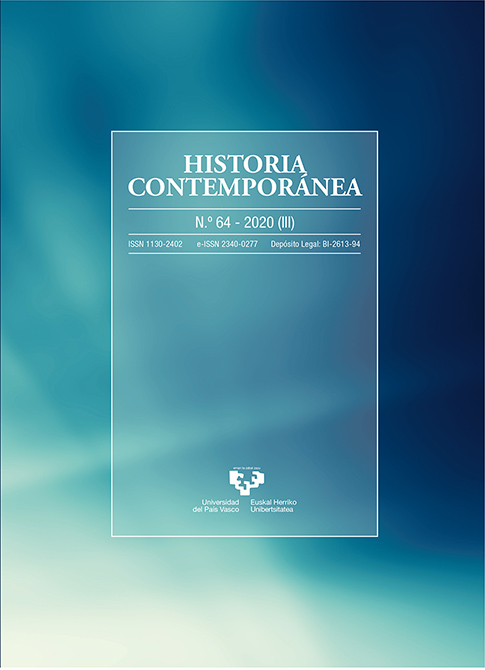"Be careful!" Danger as a Basis for Normalizing the Use of Streets in Santiago (1900-1930)
##plugins.themes.bootstrap3.article.main##
##plugins.themes.bootstrap3.article.sidebar##
Abstract
The incorporation of new motorized vehicles into urban life during the early decades of the 20th century was a conflictive process that involved both, material and symbolic transformation of the experience of traveling in the city. Focusing on the case of Santiago, this article analyzes the role of traffic accidents in this process. Specifically, it seeks to understand different ways in which the accident impacted urban culture and the notions of traffic, differentiating between the scope of the particular event and those produced by the increasingly entrenched image of the eventuality of the accident. The analysis suggests that it was the assimilation of accidents into everyday life, as an event and eventuality, which made possible the implementation and legitimation of the new circulation system that allowed the incorporation of motorized vehicles as central elements of traffic.
##plugins.themes.bootstrap3.article.details##
Traffic accidents, motor vehicles, modern traffic, Santiago
Bartrip, Peter, "Pedestrians, Motorist, and No- Fault Compensation for Road Accidents in 1930s Britain", The Journal of Legal History, 31 (1), 2010, pp. 45-60.
Bess, Michael K., "'Neither motorists nor pedestrians obey the rules': Transit law, public safety, and the policing of Northern Mexico's roads, 1920s–1950s", The Journal of Transport History, Vol. 37(2), 2016, pp. 155–174.
Bess, Michael y Del Cueto, Carla, "Seguridad vial", en Zunino Singh, Dhan; Guillermo Giucci; Paola Jirón, Términos clave para los estudios de movilidad en América Latina. Buenos Aires: Biblos, 2017, pp. 171-178.
Errázuriz, Tomás, "El asalto de los motorizados: El transporte Moderno y la crisis del tránsito público en Santiago: 1900-1927", Historia, Vol. 44, n. 2, 2010, pp. 357-411.
Errázuriz, Tomás, "When walking became serious: Reshaping the role of pedestrians in Santiago, 1900-1931", Journal of Transport History, 32(1), 2011, pp. 39- 65.
Errázuriz, Tomás, "Conductores, pasajeros y peatones: Fundamentos para una movilidad motorizada", Revista CA, núm. 151, 2012.
Errázuriz, Tomás, "La administración de Ibáñez del Campo y el impulso a la circulación moderna (Santiago, 1927-1931)", Historia, Vol. II. Núm. 47. 2014.
Foreman-Peck, James. "Death on the Roads: Changing National Responses to Motor Accidents", en Barker, Theo, The Economic and Social Effects of the Spread of Motor Vehicles, Basingstoke, UK: Pal- grave Macmillan, 1987, pp. 264–90.
Giucci, Guillermo; Errázuriz, Tomás, El viaje colectivo. La cultura del tranvía y del ómnibus en América del Sur, Talca: Bifurcaciones; Campus Creativo, 2018.
Lira, Ramón, Los viejos tranvías se van, Santiago: Imprenta de la Central de talleres de Abastecimiento, 1955.
Ishaque, Muhammad M. y Noland, Robert B., "Making roads safe for pedestrians or keeping them out of the way?: An historical perspective on pedestrian policies in Britain". The Journal of Transport History, 27/1, 2006, pp. 115-137.
Norton, Peter, "Street Rivals: Jaywalking and the Invention of the Motor Age Street", Technology and Culture, Vol. 48, No. 2, 2007, pp. 331-359.
Norton, Peter, "Four Paradigms: Traffic Safety in the Twentieth-Century United States", Technology and Culture, Volume 56, Number 2, 2015, pp. 319-334.
Rodríguez Martín, Nuria, "En una población moderna hay que saber andar. Debates en torno a la regulación del tráfico peatonal en Madrid, 1900-1936", Registros, Vol. 13 (1) enero-junio, 2017, pp. 166-179.
Oficina Central de Estadística, Anuario Estadístico de la República de Chile, [años 1925, 1929].
Rooney, David, "Keeping pedestrians in their place: Technologies of segregation on the streets of East London", en Mackintosh, Philip G.; Dennis, Richard; y Holdsworth, Deryck W., Architectures of Hurry Mobilities, Cities and Modernity. New York: Routledge, 2018, pp. 120-136.
Trapeznik, Alexander y Gee, Austin, "Accommodating the motor car: Dunedin, New Zealand, 1901–30". The Journal of Transport History, vol 38, núm. 2, 2017, pp. 213–231.
Weber, Donald, "Safety or Efficiency?: Strategies and Conflicting Interests in Belgian Road-Safety Policy, 1920–1940", Technology and Culture, vol. 56, núm. 2, 2015, pp. 394-419.
Weiss, Albert P. y Lauer, Alvhh R., "Psychological principles in automotive driving", The Ohio State University Studies, núm. 2, 1931, pp. 3-4.
West, Roscoe L., "The Philosophy of the Accident Problem", Journal of Educational Sociology, vol. 20, núm. 2, octubre, 1946, pp. 74-77.
Authors publishing in the journal Historia Contemporánea agree to the following terms:
- Authors retain full copyright of their papers, but also grant copyright to the academic publisher (UPV/EHU Press) for the purposes of copyright management, vigilance and protection.
- Papers are by default published with a non-restrictive Creative Commons CC-BY-NC-ND 4.0. You are free to: Share, copy and redistribute the material in any medium or format. The licensor cannot revoke these freedoms as long as you follow the license terms. Under the following terms:
Attribution — You must give appropriate credit, provide a link to the license, and indicate if changes were made. You may do so in any reasonable manner, but not in any way that suggests the licensor endorses you or your use.
NonCommercial — You may not use the material for commercial purposes.
NoDerivatives — If you remix, transform, or build upon the material, you may not distribute the modified material.
No additional restrictions — You may not apply legal terms or technological measures that legally restrict others from doing anything the license permits.
- If an author requires a more restricted CC license (e.g. CC-BY-SA), this can be provided by contacting our publisher at: publications@ehu.eus
- In particular, and without having to request additional permission, CC BY-NC-ND licensed papers can be deposited in institutional repositories and academic web sites.
- Postprints (i.e. accepted but non-edited versions of the manuscript) can also be pre-published online, providing acknowledgement of authorship and source is specified as above.
For non-standard uses of papers or materials published in Historia Contemporánea, please contact our publisher UPV/EHU Press at: publications@ehu.eus

